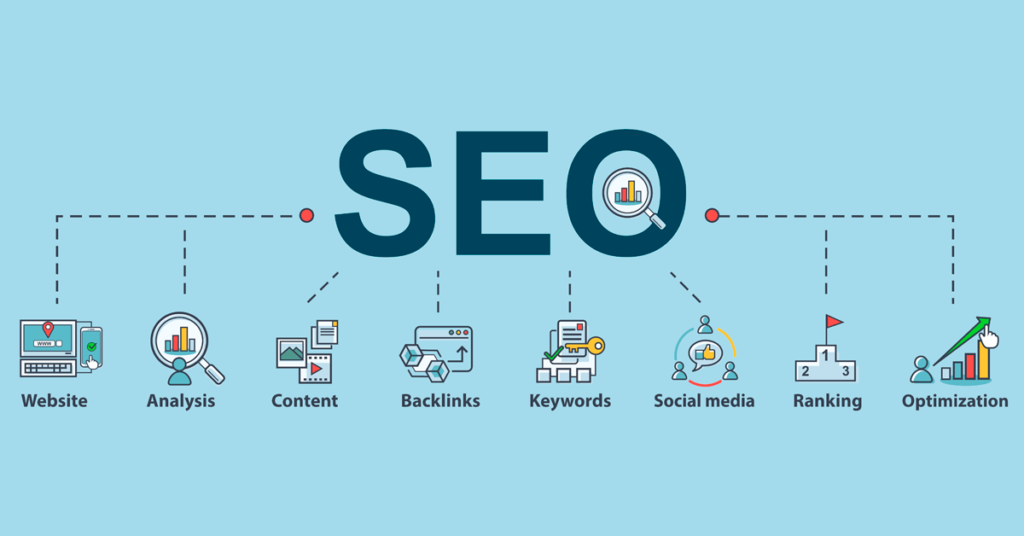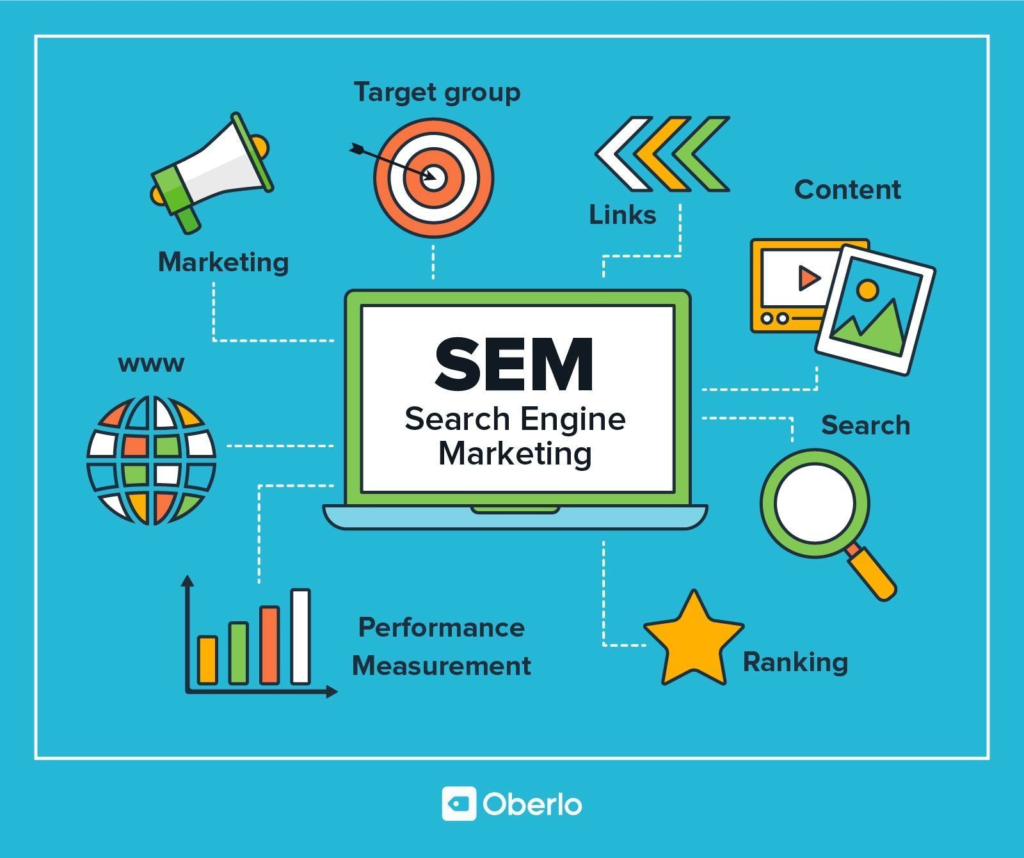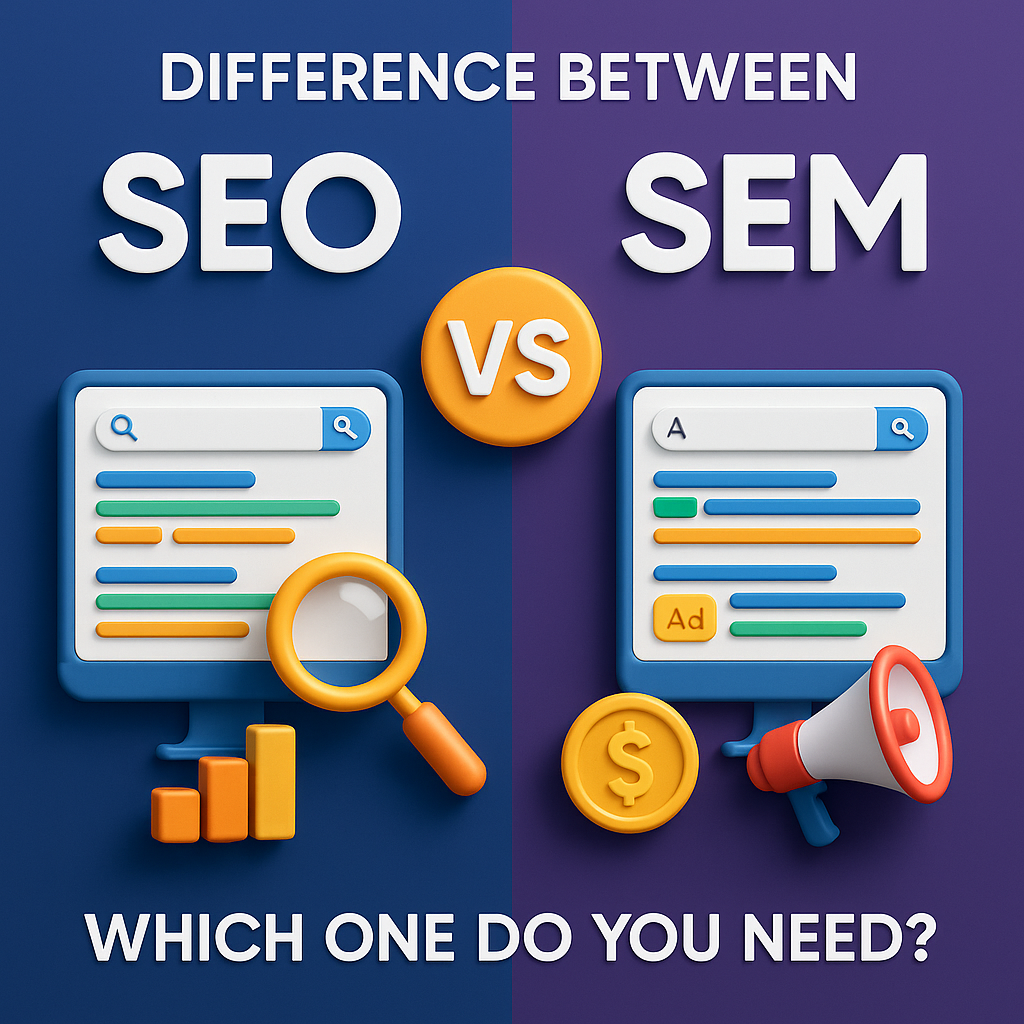
Introduction
Let’s face it, knowing how to increase your company’s visibility on search engines is essential if you operate an internet business today. However, with so many acronyms in use, it’s simple to get confused. SEO and SEM are two of the most common buzzwords you’ll hear. Although they have a similar tone and are both related to search engines, they are not the same thing.
The misunderstanding is genuine. SEO and SEM are sometimes used interchangeably. Some believe SEM to be only another fancy word for Google Ads. Others question whether they actually require either of them. Does that sound familiar?
What SEO and SEM are, how they differ, and—most importantly—which one your company truly needs will all be explained in simple terms in this book.
What is SEO (Search Engine Optimization)?

Getting free traffic from search engines like Google is the main goal of SEO, which stands for search engine optimization. Yes, it’s free. You don’t have to pay Google to be in the results, unlike sponsored adverts. By improving your website and content, you gain your spot there.
How does SEO operate, then?
Think of Google as a huge library. Telling Google that your website is valuable, reliable, and extremely relevant to what people are looking for is what SEO is all about. When done correctly, your website ranks higher in search results, increasing clicks, traffic, and sales.
The three primary foundations of SEO are as follows:
Optimizing your content and website’s headings, photos, meta tags, and keywords is known as on-page SEO.
Regarding off-page SEO, consider backlinks. These are external connections leading to your website, increasing the authority of your domain.
Site speed, mobile friendliness, clean URLs, and making sure search engines can quickly scan your site are all considered technical SEO.
SEO is a continuous process. It’s a continuous process that gradually gains traction. Although you won’t notice results right away, it will pay off greatly once it starts.
What is SEM (Search Engine Marketing)?

Search Engine Marketing, or SEM for short, is the term used to describe paid search engine optimization techniques. Pay-Per-Click (PPC) advertising, such as Google Ads, is the most popular type.
Consider SEM to be similar to hiring an online billboard. When someone types in particular keywords, you pay to appear at the top of the search results. “Pay-per-click” refers to the fact that you only have to pay when someone clicks on your advertisement.
This is a brief explanation of how SEM operates:
The keywords you wish to target are your own.
You bid on certain keywords and establish a budget.
Your advertisement shows up above the natural results when someone searches for those terms.
You pay if they click. You don’t if not.
Speed is one of SEM’s greatest advantages. SEM provides immediate visibility, in contrast to SEO, which might take months to gain traction. It’s ideal for campaigns with a tight deadline, new product launches, or situations where you simply need leads right away.
The problem is that, if you’re not careful, SEM may quickly become costly. In highly competitive businesses, the cost per click (CPC) can increase dramatically. Therefore, even while it provides speed, it necessitates a sound plan and financial plan.
Key Differences Between SEO and SEM
Now that you’ve got the basics, let’s talk differences. Even though they share a search engine as their playground, SEO and SEM are pretty different beasts.
Here’s how they compare:
| Feature | SEO | SEM |
|---|---|---|
| Traffic Type | Organic (free) | Paid |
| Cost | Time and effort | Money per click |
| Results Timeline | Slow and steady | Immediate |
| Click-through Rate | Often higher for top results | Lower unless very targeted |
| Longevity | Long-term results | Ends when you stop paying |
| Trust Factor | More trusted by users | Seen as ads |
| Strategy | Content and technical work | Budget and bidding |
So, it’s not about which one is better. It’s about which one suits your goals, budget, and timeline. In the next sections, we’ll break that down further.
When to Use SEO
When you want to play the long game, SEO is your best bet. SEO is the best option if you want to develop a loyal following, earn the audience’s confidence, and don’t have a lot of money for advertising.
Here are some reasons why SEO might be the best option:
You don’t have to pay for each click if you’re on a limited budget. Rather, spend money on SEO and excellent content.
Building authority is your goal, and SEO may help you position your company as an authority in your field.
Blog entries, manuals, and tutorials are examples of evergreen content that can continue to generate visitors for years.
When you can target precise, low-competition keywords, SEO gives you an advantage in a niche market.
But wait. SEO requires time. New websites frequently don’t see noticeable effects over six months or longer. However, once the traffic starts coming in, it’s reliable and economical.
When to Use SEM
Did you need results yesterday? Your best friend is SEM. Businesses who require immediate visibility and have the financial means to support it will find it ideal.
This is where SEM excels:
Launching a new service or product: Increase traffic to a landing page and garner immediate notice.
Running seasonal promotions: You can capitalize on the surge of interest that is time-sensitive by using advertisements.
When competing in a crowded market, advertisements can help you get in the game more quickly than SEO alone.
Targeting a certain demographic: SEM allows you to target your audience according to a variety of factors, including age, device, geography, and more.
The meter is always running, so keep that in mind. Your visibility disappears as soon as your funding is depleted. SEM therefore functions best when incorporated into a larger, carefully thought-out marketing strategy.
Can You Use SEO and SEM Together?
Yes, and you should in many situations. Although SEO and SEM have distinct functions, when combined as part of an all-encompassing digital strategy, they can work in perfect harmony.
Consider it this way: SEO is your roots, your foundation. Your focus is SEM. Together, they optimize your immediate effect as well as your long-term growth.
A combined strategy operates as follows:
Short-term gains via SEM: Use SEM to increase traffic rapidly as your SEO activities pick up speed.
Long-term SEO authority: You can progressively reduce your advertising expenditures as your SEO becomes more popular.
Data sharing: Adapt your SEO content strategy based on SEM insights, such as which keywords convert.
Increased visibility: Conquering both organic and sponsored placements gives you more space on the search results page.
When businesses combine the two, they frequently realize faster ROI, improved brand recognition, and higher click-through rates. However, careful budgeting and ongoing oversight are necessary.
Pros and Cons of SEO
Let’s break down the good, the bad, and the real about SEO:
Pros:
- Cost-effective: No need to pay for every click.
- Sustainable: Once you rank, you can stay there with minimal effort.
- Builds trust: Users are more likely to trust organic results.
- More clicks: Studies show users click organic results more often than ads.
- Brand authority: High-ranking content boosts credibility in your niche.
Cons:
- Slow results: It can take months to see traction, especially in competitive niches.
- Requires ongoing work: Algorithms change, competitors evolve—you need to stay updated.
- No guaranteed rankings: Even with perfect SEO, Google decides who ranks where.
- Takes time and resources: Great content and technical SEO require skilled effort.
SEO is like planting a tree. It takes time to grow, but once it does, it bears fruit for years.
Pros and Cons of SEM
Now, let’s shine a light on SEM—the good, the bad, and the reality.
Pros:
- Immediate results: Turn on your ads, and you can be on page one within hours.
- High targeting precision: Choose exactly who sees your ads based on location, device, behavior, and more.
- Scalable: Increase your budget and reach more people.
- Test and tweak quickly: SEM gives fast feedback—test headlines, keywords, and offers easily.
- Excellent for new products/services: Perfect when you need attention now.
Cons:
- Can be expensive: Competitive keywords mean higher costs per click.
- Short lifespan: When the budget runs out, so does the visibility.
- Requires expertise: Managing campaigns poorly can drain your budget fast.
- Ad blindness: Some users scroll past ads and click only organic results.
SEM is like renting a hotel room. You’re in a prime spot, but once you stop paying, you’re out.
Which is Better for Your Business?
Here’s the million-dollar question: SEO or SEM?
The answer? It depends on your business goals, timeline, and budget.
For Small Businesses:
Start with SEO if your budget is tight. Focus on local SEO, Google My Business, and content marketing. If you have a bit of room, test SEM with limited budgets on high-converting keywords.
For E-Commerce:
Use both. SEO helps with content (like product descriptions and blogs), while SEM can drive quick sales during promos or peak seasons like Black Friday.
For Local Services:
SEO is king here. Local pack rankings, reviews, and localized content matter. But SEM can supplement for urgent needs like emergency plumbing or legal services.
Here’s a simple cheat sheet:
| Business Goal | Choose This Strategy |
|---|---|
| Build long-term presence | SEO |
| Quick traffic for a launch | SEM |
| Budget-friendly marketing | SEO |
| Compete in tough industry | SEM + SEO |
| Need leads today | SEM |
| Establish authority | SEO |
Ultimately, the smartest brands blend both based on where they are in their growth journey.
Read more blog like this. Click Here

